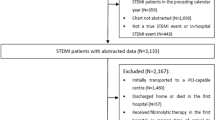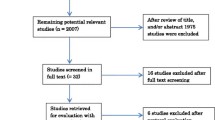Abstract
Background.Primary coronary intervention (PCI) for acute myocardial infarction should be performed as quickly as possible, with a door-toballoon time of less then 90 minutes. However, in daily practice this cannot always be achieved. Prehospital diagnosis of ST-elevation myocardial infarction (STEMI) is of major importance in reducing time to treatment, in particular when patients can be transported directly to a centre with interventional capacities.
Objectives.The aim of the current study was to evaluate the time from prehospital diagnosis of STEMI to balloon inflation and identify factors related to treatment delay in patients directly referred to the catheterisation laboratory of the University Medical Centre of Groningen.
Methods.A cross-sectional descriptive design was used to collect data on patients treated with primary PCI after prehospital diagnosis of STEMI.
Results.Median prehospital diagnosis-to-balloon time was 64 minutes for patients directly admitted to the catheterisation laboratory and 75 minutes for patients initially admitted to the coronary care unit. A delay longer than 90 minutes was observed in 18 patients. Higher age was associated with longer delay times (p=0.041). Long delays were not associated with diabetes (p=0.293), time from symptom onset to prehospital diagnosis (p=0.87) or time of day (p=0.09). Initial unavailability of the catheterisation laboratory due to running procedures contributed to longer delay times in ten cases.
Conclusion.Prehospital diagnosis of STEMI and direct referral to a catheterisation laboratory for primary PCI allows a prehospital diagnosis-toballoon time of less than 90 minutes in 82% of patients. Older patients are at risk of longer delays. (Neth Heart J 2008;16:5-9.)
Similar content being viewed by others
References
Antman EM, Anbe DT, Armstrong PW, et al. ACC/AHA guidelines for the management of patients with ST-elevation myocardial infarction: a report of the American College of Cardiology/ American Heart Association Task Force on Practice Guidelines (Committee to Revise the 1999 Guidelines for the Management of Patients with Acute Myocardial Infarction). Circulation 2004; 110(9):e82-292.
Smith SC Jr, Feldman TE, Hirshfeld JW Jr, et al. ACC/AHA/SCAI 2005 guideline update for percutaneous coronary intervention: a report of the American College of Cardiology/American Heart Association Task Force on Practice Guidelines (ACC/AHA/SCAI Writing Committee to Update 2001 Guidelines for Percutaneous Coronary Intervention). Circulation 2006;113:e166-e286.
McNamara RL, Herrin J, Bradley EH, et al. Hospital improvement in time to reperfusion in patients with acute myocardial infarction, 1999 to 2002. J Am Coll Cardiol 2006;47:45-51.
Nallamothu BK, Bates ER, Herrin J, Wang Y, Bradley EH, Krumholz HM. Times to treatment in transfer patients undergoing primary percutaneous coronary intervention in the United States: National Registry of Myocardial Infarction (NRMI)-3/4 analysis. Circulation 2005;111:761-7.
Pinto DS, Southard M, Ciaglo L, Gibson CM. Door-to-balloon delays with percutaneous coronary intervention in ST-elevation myocardial infarction. Am Heart J 2006;151(Suppl):S24-S29.
Curtis JP, Portnay EL, Wang Y, et al. The pre-hospital electrocardiogram and time to reperfusion in patients with acute myocardial infarction, 2000-2002: findings from the National Registry of Myocardial Infarction-4. J Am Coll Cardiol 2006;47:1544-52.
Bradley EH, Herrin J, Wang Y et al. Strategies for Reducing the Door-to-Balloon Time in Acute Myocardial Infarction. N Engl J Med 2006;355:2308-20.
Van Bavel H, Brenninkmeijer W, Van Ekelen D, et al. Regional implementation of the NVVC guideline on ST-elevation myocardial infarction. Neth Heart J 2005;13: 401-7.
Firanescu C, Wilbers R, Meeder JG. Safety and feasability of prehospital thrombolysis in combination with active rescue PCI strategy for acute ST-elevation myocardial infarction. Neth Heart J 2005;13:300-4.
Boersma E. Does time matter? A pooled analysis of randomized clinical trials comparing primary percutaneous coronary intervention and in-hospital fibrinolysis in acute myocardial infarction patients. Eur Heart J 2006;27:779-88.
Brodie BR, Hansen C, Stuckey TD, et al. Door-to-balloon time with primary percutaneous coronary intervention for acute myocardial infarction impacts late cardiac mortality in high-risk patients and patients presenting early after the onset of symptoms. J Am Coll Cardiol 2006;47:289-95.
Ernst N, de Boer MJ, Zijlstra F, et al. Primary angioplasty: preprocedural pharmacological therapy. Neth Heart J 2006;14:55-61.
Zijlstra F, Ernst N, de Boer MJ, et al. Influence of prehospital administration of aspirin and heparin on initial patency of the infarct-related artery in patients with acute ST elevation myocardial infarction. J Am Coll Cardiol 2002;39:1733-7.
Amit G, Cafri C, Gilutz H, Ilial R, Zahger D. Benefit of direct ambulance to coronary care unit admission of acute myocardial infarction patients undergoing primary percutaneous intervention. Int J Cardiol 2006;119:355-8.
Bradley EH, Roumanis SA, Radford MJ, et al. Achieving doorto-balloon times that meet quality guidelines: how do successful hospitals do it? J Am Coll Cardiol 2005;46(7):1236-41.
Terkelsen CJ, Lassen JF, Norgaard BL, et al. Reduction of treatment delay in patients with ST-elevation myocardial infarction: impact of pre-hospital diagnosis and direct referral to primary percutaneous coronary intervention. Eur Heart J 2005;26(8):770-7.
Primary versus tenecteplase-facilitated percutaneous coronary intervention in patients with ST-segment elevation acute myocardial infarction (ASSENT-4 PCI): randomised trial. Lancet 2006;367: 569-78.
Guagliumi G, Stone GW, Cox DA, et al. Outcome in elderly patients undergoing primary coronary intervention for acute myocardial infarction: results from the Controlled Abciximab and Device Investigation to Lower Late Angioplasty Complications (CADILLAC) trial. Circulation 2004;110:1598-604.
Author information
Authors and Affiliations
Corresponding author
Additional information
Department of Cardiology, Thoraxcentre, University Medical Centre Groningen, University of Groningen, Groningen, the Netherlands
Correspondence to: R.P. Vermeulen Department of Cardiology, Thoraxcentre, University Medical Centre Groningen, University of Groningen, PO Box 30.001, 9700 RB Groningen, the Netherlands
Rights and permissions
About this article
Cite this article
Vermeulen, R.P., Jaarsma, T., Hanenburg, F.G.A. et al. Prehospital diagnosis in STEMI patients treated by primary PCI: the key to rapid reperfusion. NHJL 16, 5–9 (2008). https://doi.org/10.1007/BF03086109
Issue Date:
DOI: https://doi.org/10.1007/BF03086109




